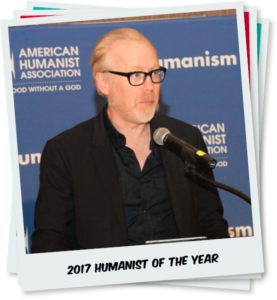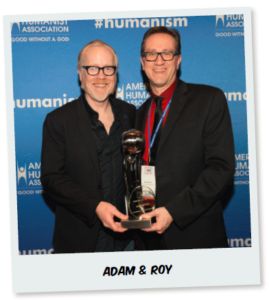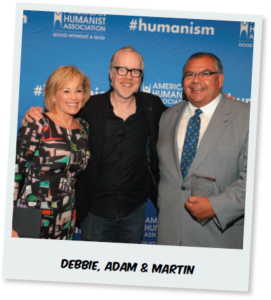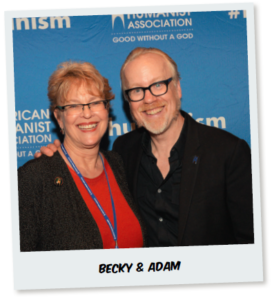Building Humanism, Busting Myth and Privilege
 All photos by Scott Weldon
All photos by Scott Weldon ADAM SAVAGE is, broadly speaking, a maker of things, having built everything, as he’s characterized it, “from ancient Buddhas to futuristic weapons, from spaceships to dancing vegetables, from fine art sculptures to animated chocolate—and just about anything else you can think of.” A special effects expert who worked on over 100 TV commercials and a dozen feature films, Savage is best known as the co-host (with Jamie Hyneman) of the popular Discovery Channel show MythBusters, on which the two scientifically tested the validity of all manner of rumors, myths, movie scenes, internet videos, and news stories. The show premiered in 2003 and ran for fourteen years, or, as Savage puts it, after “1,015 myths, 2,950 experiments, eight Emmy nominations, and eighty-three miles of duct tape.”
Today, Savage stars in and produces digital content for Tested.com, including One Day Builds, Inside Adam’s Man Cave, and Untitled: The Adam Savage Project, a podcast with Will Smith and Norman Chan. He also lectures widely, makes appearances at events like Comic-Con, Maker Faire, and w00tstock, and pursues his talent for sculpture. On June 9, 2017, Adam Savage appeared at the American Humanist Association’s conference in Charleston, South Carolina, to accept the Humanist of the Year Award. The following was adapted from his remarks.

Savage with AHA Executive Director Roy Speckardt
When I look at the list of intensely accomplished people who’ve received the Humanist of the Year Award before me and see how many intellectual giants as well as people I love and admire are on that list, I am moved more than you know. I humbly thank you for the privilege of addressing you all.
I’m speaking to you during a tumultuous time. And I’d like to speak to some subjects that I think are relevant to what’s going on today, and that are close to my heart. Like you, I seek a better world through clear vision, deeper understanding, and building communities of trust for the betterment of all life. And when I say it’s my privilege to be here, I mean this in the deepest possible sense. I am privileged to have been born white in the United States to upper-middle-class, intellectual artistic parents, who provided me with tremendous love and support both financial and emotional. As I bounced around in my adolescence, late teens, and early twenties before figuring out what the hell I was good at, the leg up that they gave me was real, and I will benefit from it for the rest of my life.
I have eighteen-year-old twin boys, “Thing One” and “Thing Two” I call them. And there is this thing about eighteen. Raising kids feels like the directions you put into your GPS when you first had children: you think, “let me just get them to eighteen. How do we get there?” And so, you’re driving along and at seventeen you think, “Whoa, we’re almost there.”

Savage with AHA board member Debbie Allen and fellow awardee Martin R. Castro
Then they turn eighteen, and it’s like the GPS is recalculating, and it turns out there are hundreds of miles left to go. I’ve raised these two boys in even greater privilege than I was raised in, but I’ve worked hard to teach them how to see their place in the world for what it is—to see the wider world more clearly for all of its wonders and its faults. I’ve tried to instill in them a set of humanistic values with which they would be productive citizens of the planet. And when I say productive, I don’t just mean having a good life for themselves and their families, but also the act of aiding and abetting the improvement of life for all.
When I first started making MythBusters, after the show had found some traction, I noticed that when we went to experts and scientists and engineers, they treated me differently than I expected. They were talking to me as if I were a peer. (I have a high school diploma, by the way. And a package design class at the School for Visual Arts.) Anyway, the scientists we encountered were talking to me as if I were a peer, taking my insights seriously and sharing theirs with me openly and with enthusiasm. This gave me both tremendous delight and real confidence. It was like I had unlocked a new level to a game I didn’t even realize I was playing. It’s important to point out that in the beginning of making MythBusters, we didn’t think of it as a science show. We were just trying to answer the questions that were put before us. (And I guarantee you, we were not “thinking of the children.”) I considered myself a science geek, but with my high school diploma and my crappy educational work ethic, I was far from a scientist in my mind. I placed science in the category of things that smart people did, and by doing that, I placed myself outside that category. This was my own personal bias. And with that bias, I was limiting myself and what I could contribute to the world. Spending fourteen years making MythBusters with Jamie and my amazing crew, I’ve come to understand that I am, in fact, a scientist, and this realization has changed me fundamentally.
Privilege and bias. We talk about these things cursorily and often defensively these days, but without the depth that I think is necessary for the lasting and ultimate benefit of our planet. When we talk about bias, for instance, we often center upon personal bias. When people encounter the subject of racism, they do a double check on themselves, remind themselves that they’re not racist, and thus, the problem’s probably solved. They move on.
I did this. When confronted with ideas of privilege, many in the privileged categories feel defensive and look at the myriad, crushing difficulties of their own lives—financial, emotional, familial. And they conclude that privilege is ephemera, a false construct. My friend, the wonderful science fiction writer John Scalzi, puts it this way: privilege doesn’t mean you get a free pass, but in the video game of life you get to play with all the settings on easy. This means you can still lose. And you will suffer because this is the first noble truth of the Buddha: we will all suffer. Nobody escapes, but truly, nobody suffers like the poor and the really marginalized communities.
Years ago, I came across a wonderful longitudinal study about nuns in a convent. They had all taken their vows at roughly the same age, between eighteen and twenty-two years old. And they were studied for decades. I think this study began in the 1930s. These were women who lived in identical conditions, eating the same food, enduring the same weather and schedule with each other for the majority of their lifetimes. And yet, the study found that the single greatest predictor of their late life health and longevity was their socioeconomic status at the moment they took their vows. And that’s also what I mean by privilege. It is systemic.

Savage with AHA President Rebecca Hale
Many have claimed that we are in a post-racist society and that all is a level playing field. Being able to see the world in this way is itself a form of deep privilege, because the long tale of our damaged past is buried deep within the societal constructs that we’ve built into our countries and governments and our cultures over the past few millenia. Systemic and institutional bias and privilege are, in my opinion, currently the greatest threats to human progress. My personal commitment to myself, to the betterment of the people around me, and my desire to see more clearly the bias and privilege that occurs both for myself and in the world is what makes me a humanist.
I have, in recent years, purposely distanced myself from the specific categorical words “skeptic” and “atheist.” In both cases, I conclude that it isn’t useful for me to define myself by what I don’t believe, but also because of the problems I’ve encountered with some who identify as such. To be clear, I’ve made some of my most important friendships and deeply important collaborations within these communities and the people steeped in them. And I am the better for it. But I’ve also encountered just as much blind privilege, idiocy, small thinking, sexism, misogyny, racism, and bias as anywhere else in the world. When famous atheists outright deny their own privilege when it’s pointed out to them or advocate for profiling dark-skinned people as sound security policy, I choose to run in the opposite direction and find my own path. If you follow me on Twitter, you know that I’m not afraid to speak my mind. I voice my opinions about the current political situations around the globe with passion and all the articulacy and data I can bring. But I also bring love. I have, in fans of MythBusters, many who vehemently disagree with my politics. But I might have their attention and so I seek to speak to them and to reach them, and I am rigorously polite and loving in my disagreement. Let me pause here and say that I enjoy some privilege in this regard. Because when I tweet political stuff, people are polite back to me, even those who strongly disagree. It is the very rare comment that is quite insulting to me, which is appalling when I think about someone like Skepchick founder Rebecca Watson who received rape and death threats for years from those who disagreed with her.
I take it as a given that most of the people I might disagree with are still starting from the same basic principles that I am, that we want to leave a better world for ourselves and our kids and our loved ones. That our disagreement is one of method and that we can find common ground if we are civil, balanced, and thorough in our desire to share our opinions and to help each other and ourselves see clearly the world’s delights as well as its warts.
James Baldwin famously said, “Not everything that is faced can be changed. But nothing can be changed until it is faced.” I choose to face my own biases (as a recovering mansplainer), with privilege as a starting point to help myself and others face it where it exists most perniciously and in the cultural and temporal institutions we have often inadvertently and sometimes intentionally built to benefit a few, at the expense of the many. I’m not advocating a specific political system or party or ideology. This is simply my definition of humanism, and I am grateful beyond measure to be able to share it with you. Thank you.
Excerpt from the Q&A
Q: Do you have any other future shows or projects planned where you can continue teaching critical thinking or science to a general audience?
Adam Savage: Absolutely. I’m working on it all the time. A few years ago Tom Kalil from the Office of Science and Technology Policy under President Obama asked me to help teach kids the transformative power of being able to reach out and manipulate some part of the world. Whether it’s fashion design, rapping, dancing, coding, carpentry and welding—when a child reaches out and manipulates their world, they are in fact making their world a little bit better. They’re choosing a thing and they’re bringing it into being. I started out in Cleveland—now, one of my favorite cities in the United States—and witnessed a city looking hard at itself in the aftermath of the economic downturn to see how it could mend racial, class, and economic divides by equalizing access for children to be able to have agency in their world.
By the age of thirteen, little girls can be so afraid of demonstrating failure that they’d rather tell their coding teacher they didn’t do the assignment than show five pages of code that doesn’t work. We talk about teaching kids how to fail—actually, we talk about this a lot—how to fail safely. It’s not failure. It’s iterative success. Failure is getting drunk and missing your kid’s birthday party. What we mean here is that when you set out to bring something into being that didn’t exist, it’s never going to be what you thought. That’s actually not only part of the process, it’s the reason we do it. It’s the reason every artist starts a painting because they don’t know where it’s going to end up. It’s the punchline of Kurt Vonnegut’s favorite dirty joke, “Keep your hat on, we might end up miles from here.”
And so, that’s a long winded way of saying that I consider it my mission to share my passion, my weird, hilarious hobbies of costuming and making movie props. I pay obeisance to those obsessions and I recognize them for the strength that they give me. And I want to foment that empowerment in kids.
Q: Did you ever expect the Duck Bomb to be as popular as it was?
A: No! That’s my favorite part about being a communicator—you never know what’s going to hit and what’s going to resonate. And the fact is, is when you’re on the stage, when you’re communicating with an audience, you are getting feedback. And the same thing happens online with page views and commentary. I don’t read the YouTube comments but I do read them from the Tested community. I take them really seriously, and I love looking deeper into the fact that the things that do seem to resonate are my enthusiasm and my enjoyment of things. If that’s my brand, then I’m ready to keep on bringing it any way that I can.
Q: I’m very interested in making and building and that sort of thing as a hobby. I was wondering, in the context of organized humanism, religion, social justice, and so forth, if and how making and building has created a common ground for you to communicate to the other side, whatever that side may be.
A: It does, because the things I’m doing are universal. And I might be wrong about this. But I’m taking it as axiomatic that you can’t seek excellence in making beautiful things—and I mean that in the broadest possible sense—without looking deep inside yourself. The best job you’ll ever have is also the hardest because it’s going to require all the introspection you can bring. As with anything that’s important to you, you’ll get stripped down to your bones by your kids and by your marriage and by doing the things that are important to you. That’s called living in my opinion. And I don’t think you can seek excellence in making stuff without having a humanist bent towards life.
I take solace in reading Taylor Branch’s biography of the Civil Rights Movement and hearing how much Dr. Martin Luther King struggled with his faith. As far as I’m concerned, it should be a struggle. It should be something that we question all the time. I think that we look at things as other when we don’t understand them. If you look at the electoral map of the United States, every major city is blue surrounded by a sea of red. There are no big cities in America that are red. It is the proximity of bringing people together. So to me, making is about building communities and it’s about equalizing access and making sure everyone has that access—for example, making sure that schools other than white private schools have not only maker spaces but libraries and rec centers and other creative community spaces.
Q: Hi, Adam. I’m one of those scientists and engineers you talked about who thinks of you as a peer. Do you see a path forward for us to be able to elevate scientific thinking into the common culture so that we can all be scientists of a sort, without having to be pigeonholed experts in our little branch of academic science?
A: I really hope so. I see a large portion of our culture, namely in online communities, becoming deeply imbued with scientific thinking. I grew up with Carl Sagan and he was it. But now, we’ve got Neil deGrasse Tyson, and Bill Nye, and Phil Plait, and me… and there’s tons more. There’s Nanogirl in Australia, and so many other amazing popularizers of science.
One of the greatest parts about Tested.com is that I can provide a platform for folks. We’re going to Black Girls Code soon to cover them for part of the video series I’ve been doing about non-standard maker spaces around the country.
Something I’ve learned to do is to take my own counsel, and I realize that it started with getting radicalized by Noam Chomsky in my late teens. Because Chomsky was super rigorous in everything that he said. In Manufacturing Consent he said, look, I conclude this about the New York Times approach to East Timor and our American government’s plans there by counting the column inches devoted to these types of stories. But please don’t take my word for it. I’m insisting. Go count the column inches yourself. Go to the New York Public Library. Get the microfiche. Read it. And that really sunk into me.
When I started making MythBusters, I read a study by some researchers who figured out that if you’re standing five feet from me or twenty feet from me, my vision of you is equivalent to a certain amount of Gaussian blur, depending upon your distance. And they figured this out empirically by experimentation. But I read that and I thought, yeah, we can learn a lot when things move. So, for example, when I move, there’s something else happening other than the Gaussian blur because of the lights moving across the topography of my face. And that’s giving my brain all this topographic information and that’s something other than blurriness. So, with my newfound excitement that people were treating me like a peer, I thought, I’m going to write to these scientists and ask them, hey, have you considered movement? And they sent me back this shitty email that was kind of like, yeah, stay in your corner TV boy. And I remember getting upset about it. And then, I remember feeling great that I was upset about it because I actually think I had something to contribute.
One of my favorite memories in the early days of MythBusters was when we were in South Africa filming the great white sharks, the ones that leap straight out of the water. There was a storm that came in and we were kept off the water for three days. It was very expensive for us to be in South Africa with our whole crew—MythBusters did not travel extensively—and we had a decision to make. How were we going to get the amount of footage we needed for this one-hour episode under the costs that we had? So we decided, let’s go inland. We’re in Africa. Let’s test if elephants are afraid of mice.
We went to a woman who raised mice to feed to monkeys. (That was a horrifying thing to witness by the way.) We got some mice and built an experiment where we decided to reveal the mouse to the elephant by taking a piece of elephant dung, cutting it in half, carving it out, and making a little shell. We put this very unhappy white mouse inside. Elephants are like cows or humans—they follow the same paths. So, we put our little dung cage on an elephant path and waited for an elephant to come by, and then we pulled this piece of monofilament, and the dung revealed the mouse. The elephant stopped, reared back and then gingerly stepped well to the side and around the mouse and continued on. Holy cow, we said, and then we thought, wait a minute. Maybe elephants are afraid of animated dung. So let’s run this again. We thought we were producing five minutes of comedy filler for an episode, but all of a sudden we had a result that we needed to control. So we thought, okay, maybe elephants are afraid of animated dung so we just did it without the mouse. Didn’t get the same result. Okay, we said, let’s test again with another elephant. And this elephant sidestepped the mouse just as the first had. Well, we concluded, they might not be afraid of mice but they’re certainly afraid of stepping on them. That was one of my favorite results on the show.
And then, about a year later, I’m in Seattle doing a talk for 6,000 people, and I’m taking questions from the audience. This seven-year-old girl gets the microphone. And there’s this great thing that has always happened on MythBusters with science kids, which is they’re just as freaked out as any other kid to see someone in person who’s been on their television for years. But the science kids, they go through this extra process of like, right, but there’s something I actually had a question about. And so she’s stammering a little and says, “I, I, I was wondering why you used white mice because they’re not really natural in nature and why you didn’t use a normal-colored mouse.” And I said, “You are totally right! You’ve just illustrated the central problem with our experimental procedure. I’m really sorry about that.” And I loved being dressed down by a seven-year-old girl. That was the best.
